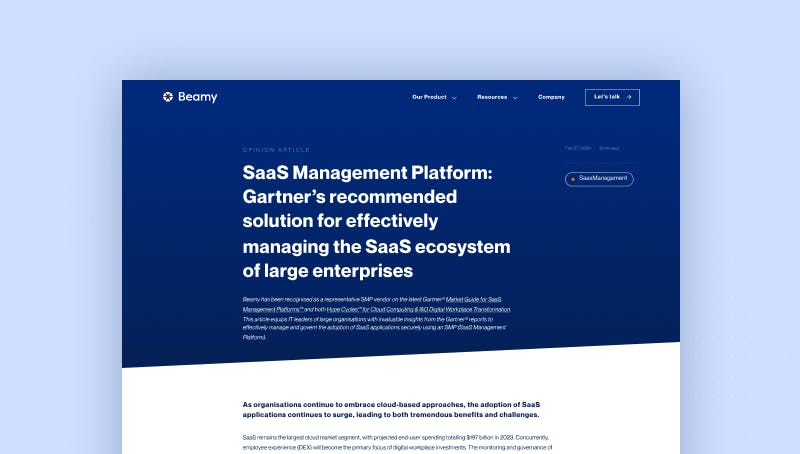Beamy has been recognised as a sample SMP vendor on the latest Gartner® Hype Cycle™️. This article provides insight into how large organisations (>1000 employees) can overcome their “lack of awareness, maturity or priority to drive SMP investment”.
The Gartner® Hype Cycle™️ explores the ‘hype’ of Digital Workplace solutions, their maturity, adoption and potential to support organisations’ business and abilities. A Digital Workplace is a virtualised ecosystem of workplace technologies allowing collaboration among employees.
SaaS Management Platforms (SMPs) remained at the ‘peak of inflated expectations’ in this 2022 report, as their advanced machine learning capabilities and powerful algorithms are able to streamline the coordination between other components of the Digital Workplace.
SMPs are particularly tailor-made to fit right into the changing dynamic of the Digital Workplace and have shown exceptional potential in enhancing the Digital Employee Experience (DEX) - which has been the priority of IT departments lately.
Factors explaining the ‘SMP-hype’:
- The continuing effects of the pandemic fuel new needs for the digital employee experience: hybrid working styles, team collaboration solutions, digitalisation of business units by themselves and more, resulting in the adoption of SaaS applications - a phenomenon interpreted as ‘the democratisation of technology’ within large enterprises.
- SaaS adoption is at an all-time high in large organisations that are past the phase of ‘interest’ in just implementing new, innovative SaaS solutions and into the phase of ‘understanding’, that their existing SaaS portfolio requires their undivided attention urgently.
- Decentralised responsibilities and uncontrolled risks resulting from the SaaS sprawl, are now inevitable and should be pushed to the forefront of IT’s priorities to be attended to, along with issues like suboptimal SaaS ROI.
- SMPs hype is not limited only to the IT departments' interests in streamlining the SaaS lifecycle and related stakeholders in their organisations. But extends to the interests of the innovative end-user - who prefer to choose their technology solutions autonomously, and a ‘SaaS directory’ (SMP feature) allows them that flexibility.
Choose the most relevant SaaS from a directory of over 50K SaaS
The 3 takeaways from Gartner's study:
1st takeaway:
“Many organisations do not fully understand the sprawl of their SaaS portfolio and underestimate the prevalence of shadow SaaS. This results in a lack of awareness around SaaS management needs.”
GartnerOver 30% of new SaaS tools are added yearly to Beamy's client organisations’ tech portfolio. According to Gartner's research, an average of 30-40% of the IT budget is spent on tools the IT team doesn’t know about. These figures are alarmingly underestimated in organisations and such is their understanding of the SaaS sprawl and the associated risks. Lack of regard for shadow SaaS or budget overruns has fewer consequences than the implications they create - exposure to cyber threats, noncompliance with data protection regulations and other IT vulnerabilities.
2nd takeaway:
“Larger organisations tend to not have awareness, maturity or priority to drive SMP investment. SMP adoption is higher in small to midsize organisations as centralised responsibility for SaaS is more common.”
GartnerLarge groups are often resistant to substantial changes and are bound by a heavy-legacy centralised IT system, unlike the digital-native SMBs. A decentralised IT typically has 800 collaborators in sync for 400 SaaS applications and is generally a characteristic of large organisations. Often concerned about “an addition of another management tool”, these large groups are found to lack awareness that SMPs are explicitly designed to facilitate crucial changes in legacy systems and organise their existing decentralised IT landscape.
3rd takeaway:
“More mature clients are struggling to choose between SMP, SaaS security and SAM. All three offer SaaS discovery, protection and some optimisation capabilities, however, all six functions can be provided only by a SMP.”
GartnerBy definition, the 6 core functions of SMPs are to discover, manage, automate, optimise, secure and govern the SaaS apps. It seems that organisations that have already implemented alternative tools to SMP are often unsatisfied with their limited capabilities, which also explains the popularity of SMP tools.
Conclusion:
The innovation in Digital Workplace technologies can be overwhelming if organisations lack the maturity to implement effective solutions at the right time. SaaS adoption must be in tandem with SMP adoption to avoid creating an overgrowth of long-tail shadow SaaS and maintain a comprehensive view of the organisation’s SaaS stack over time. For larger groups, the time they take to understand their SaaS sprawl will be the time lost when they could’ve reacted proactively to the inevitable SaaS explosion.
Detect all SaaS applications within your organisation and their impact on your IT budget and data security.
Gartner® Hype Cycle™ for Digital Workplace Infrastructure and Operations, 2022; Autumn Stanish, Pankil Sheth, Stuart Downes; 21 July 2022
Gartner does not endorse any vendor, product or service depicted in our research publications, and does not advise technology users to select only those vendors with the highest ratings. Gartner research publications consist of the opinions of Gartner's research organization and should not be construed as statements of fact. Gartner disclaims all warranties, expressed or implied, with respect to this research, including any warranties of merchantability or fitness for a particular purpose.




